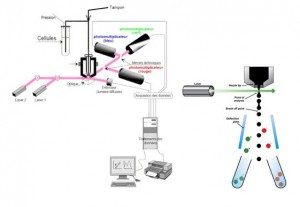About
Cytometry is the quantitative analysis of cells and cell systems. Popular examples are flow cytometry and image cytometry, which are primarily optical methods, but the term can apply to any methodology used to extract quantitative information from individual cells.
In general, cytometry measures optical properties of cells, and most often uses fluorescence to measure specific antigen molecules using antibodies, intracellular ions using indicator dyes, and DNA and RNA using nucleic acid-specific probes. In addition, cytometry measures a host of other cellular features and behavior including cell viability, morphology, proliferation, secretion, endocytosis and phagocytosis, to name just a few. Other optical signals can be measured, including light scatter. Cells may be live or fixed, depending on the application, and individual cells can often be physically sorted.
Flow cytometry is generally used for the multiparameter analysis of individual cells in suspension, and is widely used in immunology and haematopathology. Hallmarks of flow cytometry are analysis speed, detection sensitivity, the ability to measure many parameters simultaneously, and the ability to sort individual cells. Recent trends in flow cytometry technology include single cell spectroscopy, single cell mass spectrometry, imaging of individual cells in flow, and the development of small inexpensive flow cytometers and sorters.



